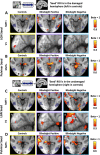Blindsight relies on a functional connection between hMT+ and the lateral geniculate nucleus, not the pulvinar
- PMID: 30044775
- PMCID: PMC6078309
- DOI: 10.1371/journal.pbio.2005769
Blindsight relies on a functional connection between hMT+ and the lateral geniculate nucleus, not the pulvinar
Abstract
When the primary visual cortex (V1) is damaged, the principal visual pathway is lost, causing a loss of vision in the opposite visual field. While conscious vision is impaired, patients can still respond to certain images; this is known as 'blindsight'. Recently, a direct anatomical connection between the lateral geniculate nucleus (LGN) and human motion area hMT+ has been implicated in blindsight. However, a functional connection between these structures has not been demonstrated. We quantified functional MRI responses to motion in 14 patients with unilateral V1 damage (with and without blindsight). Patients with blindsight showed significant activity and a preserved sensitivity to speed in motion area hMT+, which was absent in patients without blindsight. We then compared functional connectivity between motion area hMT+ and a number of structures implicated in blindsight, including the ventral pulvinar. Only patients with blindsight showed an intact functional connection with the LGN but not the other structures, supporting a specific functional role for the LGN in blindsight.
Conflict of interest statement
The authors have declared that no competing interests exist.
Figures





References
-
- Weiskrantz L, Warrington EK, Sanders MD, Marshall J. Visual capacity in the hemianopic field following a restricted occipital ablation. Brain. 1974; 97: 709–28. - PubMed
Publication types
MeSH terms
Grants and funding
LinkOut - more resources
Full Text Sources
Other Literature Sources

